

|
Soundclip:
|
|
Steve
Khan's
lead
sheet: 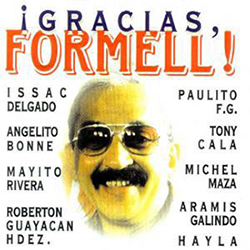 I spent lots of nights, usually Thursdays and Saturday night at THE LATIN QUARTER, which was located then on Broadway between 95th St. and 96th St.! I used to go with a small notebook and I would write down all of the songs that I was hearing the DJ play while inspiring the dancers to get out on the floor and bailar!!! Then, after arriving home, I would initially take that information and go out on CD buying sprees. As my knowledge began to grow about the vast and rich history of Latin music and Salsa, I began to realize that, for the most part, the clubs in New York were playing a mixture of the contemporary Salsa Romántica, and some tougher sounding and feeling Salsa from the '70s and '80s, which most experts saw as the great Fania epoch of the music. Everyone, especially musicians told me that THAT was where I would find the best music and the best songs and albums. Armed with that, the buying sprees and explorations continued. I even went downtown to take some weekly Salsa dancing lessons. I learned a lot, but most of it did not seem to be too useful in the clubs! It was a source of tragi-comic laughter often times. I spent lots of nights, usually Thursdays and Saturday night at THE LATIN QUARTER, which was located then on Broadway between 95th St. and 96th St.! I used to go with a small notebook and I would write down all of the songs that I was hearing the DJ play while inspiring the dancers to get out on the floor and bailar!!! Then, after arriving home, I would initially take that information and go out on CD buying sprees. As my knowledge began to grow about the vast and rich history of Latin music and Salsa, I began to realize that, for the most part, the clubs in New York were playing a mixture of the contemporary Salsa Romántica, and some tougher sounding and feeling Salsa from the '70s and '80s, which most experts saw as the great Fania epoch of the music. Everyone, especially musicians told me that THAT was where I would find the best music and the best songs and albums. Armed with that, the buying sprees and explorations continued. I even went downtown to take some weekly Salsa dancing lessons. I learned a lot, but most of it did not seem to be too useful in the clubs! It was a source of tragi-comic laughter often times.During that time, lots of musicians were talking about all of the great Cuban music, new and old, and so, I began to explore that music and its own rich history. It was strange to me how virtually NONE of the clubs here in New York were playing any of the newer Cuban music, much less the older Cuban music. But along the route somehow, I discovered the music and recordings of sonero, Issac Delgado, and that seemed to change everything - including my buying habits. And then, through some really good friends amongst musicians, I learned that Issac Delgado was coming to the USA for some concerts, several right here in the New York City area, and so, I went to see Issac's incredible group of young players in our Central Park in 1997, and that was a pivotal moment for me. I was allowed to sit off to the side of the stage, and to watch and listen. For me, it felt as though the entire spirit/soul of the island of Cuba was bursting forth, and with a kind of energy and passion that is not always seen in most musical presentations. At that moment, I didn't know a lot of the songs that they were playing. It seemed like it was all new stuff to me - though in truth, a lot of the set was not brand new. Not long after that, Issac Delgado was to record his album "OTRA IDEA"(RMM), mostly using musicians from here, though his keyboardist Iván "Melón" Lewis was present to give the music the right feeling. In its way, that album caused a bit of sensation here, especially the song, "De Que Roberto Te Toque." It still remains amazing to me that THAT song was placed LAST in the sequence!!! I guess Ralph Mercado didn't like it, or thought that NO ONE else would like it, or dance to it. How very wrong he turned out to be!!! It wasn't too long after all of this that I happened to stumble upon a CD titled, "¡GRACIAS, FORMELL!," which I thought had contained a song of Issac Delgado's that I didn't have. And so, I bought it not really knowing what it was going to be. Though I did know that the great bassist and bandleader Juan Formell was the guiding light behind one of Cuba's most visionary and important bands, LOS VAN VAN, I really hadn't put it all together about his profound songwriting capabilities. Sadly, the great Formell left us in May of 2014. On this album, I just loved the interpretations of his songs by such artists as: Issac Delgado "Tú, Tranquilo"; Michael Maza "La Candela"; Haila Monpié "Recaditos No"; Mayito Rivera "Mis Dudas" and lastly, 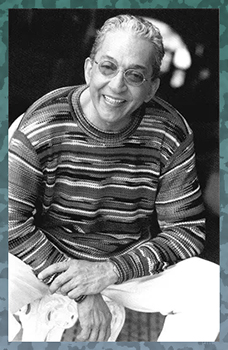 but best of all for me was, Ángel "Angelito" Bonne and his interpretation of "La Habana Joven." I thought to myself, "Wow! What a great song, and what a fantastic arrangement by Juan Manuel Ceruto. Sadly, at that moment, and for years, none of the musicians were listed anywhere, and I still had not been able to track down that vital information. However...... but best of all for me was, Ángel "Angelito" Bonne and his interpretation of "La Habana Joven." I thought to myself, "Wow! What a great song, and what a fantastic arrangement by Juan Manuel Ceruto. Sadly, at that moment, and for years, none of the musicians were listed anywhere, and I still had not been able to track down that vital information. However......Wow! It turns out that a wonderful longtime fan somehow discovered a complete listing of the musicians and singers who appeared on "¡GRACIAS FORMELL!" - so now, I can share with all of you the wonderful musicians and singers who made "La Habana Joven" so very special: Emilio Morales (Keyboards); Frank Rubio (El. 5-String Bass); Joel Páez (Timbal); Tomás Cruz (Conga); Carmelo Andrés (Trumpet);Alexander Abreu (Trumpet); William Paredes (Trombone); Julio "La Bala" Montalvo (Trombone); Juan Manuel Ceruto(Tenor Sax & Güiro) and Gema 4 (Coro): Estela Guzmán-Odette Tellería-Michèle Alderete-Laura Flores. On an additional note, I was reminded by Michèle that we had actually met here in New York when I attended the show of Gema 4 at The Bottom Line on Wednesday, April 22, 1998. She also told me that I had given her several of my CDs. I was stunned because I hadn't remembered this at all. But, when I went to my Datebook for that year, the confirmation of all of this was right there. How about that?!?! At a certain point in time, and much later, I had to investigate the original version of this song, it was not on any of the Los Van Van CDs that I had - and by that time, I had a lot of them. It turned out that it appears on an album titled: "THE BEST OF JUAN FORMELL Y LOS VAN VAN" but actually, it came from the 1974 album, "LOS VAN VAN"(Areito). Apparently this same song, the original version by Los Van Van was the theme song for the novela, "MI CASA GRANDE," though I'm still not certain of the exact year of this TV show. But, the most striking thing about the original version is that it is so completely different than the version that I fell in love with. Yes, it does begin in one key harmonic area, and then, with the successive verses, does modulate - but, the basic 2-bar vamp remains the same. In its original key, the chords move from: ||: Ebmajor - Eb/Db - Abmajor/C - Abminor/Cb - Eb/Bb :||. When you listen carefully to the Juan Manuel Ceruto arrangement, you really won't believe just how very, very creative he was in making so much more, harmonically speaking, out of what was there in the original. It's simply fantastic! And it was because of that aspect alone, as some point in time, I was inspired to actually write out a lead sheet of the romantic Cha-cha-cha just to see and better understand what he had done with it. The great bassist Rubén Rodríguez tells me that the original version is a Cha-cha-cha too - with, as he puts it, "other elements - especially the drums." I see Juan Formell's song, "La Habana Joven" as a beautiful love poem to his Havana, to youth, and to the innocence and beauties of being young - and in love. These are all things to be celebrated in words and song. Now, let us take a look at Juan Manuel Ceruto's wonderful arrangement of this great song. Firstly, it should not be overlooked that Juan Manuel is a tenor saxophonist! When you hear the [I]ntro that sets the tone, if you listen carefully to the terrific phrasing of the horn lines, you can tell that J.M. is a person who appreciates and understands Jazz phrasing. Look at how many of the phrases end with long-short indications. These small but essential details are so important. Harmonically speaking, the entire arrangement has a Jazzman's harmonic sensibilities, and those chordal colors and details are in the Fender Rhodes part. I don't know that they were specifically written in, or that the player is just gifted with those musical instincts, but either way, it is all beautifully done. I wish that I could properly credit the keyboard player, but try as I might, I have not found any listing anywhere for the personnel on this entire recording. Whoever he might have been, he did a fantastic job of coloring the harmonies within the arrangement. Often times in contemporary Salsa, a Fender Rhodes-esque sound is rarely used, especially if the sustain pedal was going to be employed a lot. 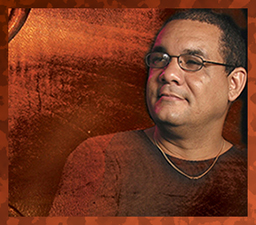 This is because that sound just can't really compete with all of the great sounds of Latin percussion. Most of the time, some kind of acoustic piano sample is used, because that becomes the most traditional and percussive solution for the keyboard. Even if a synth electric piano sound is chosen, it is often super-percussive and, to my ears, very abrasive sounding - or, it can be. One must never forget that the acoustic piano IS a part of the percussion family of instruments, because the hammers strike the strings. This is because that sound just can't really compete with all of the great sounds of Latin percussion. Most of the time, some kind of acoustic piano sample is used, because that becomes the most traditional and percussive solution for the keyboard. Even if a synth electric piano sound is chosen, it is often super-percussive and, to my ears, very abrasive sounding - or, it can be. One must never forget that the acoustic piano IS a part of the percussion family of instruments, because the hammers strike the strings.The song itself contains 6 verses, and begins in D major. The first modulation, after Verse 2, goes up a whole-step to E major, where it remains through Verse 4. The last modulation takes us to Gb major for Verses 5-6. Ceruto's usage of lush harmonies with harmonic extensions added to the major, minor and dominant sonorities contribute to the Jazzy feeling of everything. In the little horn figure going into Letter [B] and the modulation to E major, the last beat of that bar offers a horn cluster that includes the interval of a maj2nd, which is another very Jazzy touch. Obviously, I have listened to this song on countless occasions, mostly just for pure enjoyment, but in preparing this piece for the website, I wanted to try to make certain that I was hearing some of the details, where the horns were concerned, in the best possible way. I wasn't always certain just how many horns were playing at any given time, so I had to call upon my close friend and constant musical colleague, the great Rob Mounsey to see if he heard what I was hearing. He confirmed that, in general, overall, that he heard 2 trumpets, tenor sax and trombone. To my ears, most of the time, like the [I]ntro, I hear just 2 trumpets. Then, here are there for accents or horn stabs, the other two voices (tenor sax and trombone) can be added in. So, keep that in mind as you are listening - especially if you are a musician. As I was studying Latin music and, as usual, desperately trying to catch-up, I was always so confused as to what the clave might be for any particular song - and no matter how much I studied, how many music books that I bought and read, it felt like I was never going to get it. Amongst the wonderful tips that I got from my fellow musician friends was to "listen to the horns" and that could tell me what the clave is. Within Ceruto's arrangement, following those words becomes perfection. Most Cha-cha's, to these ears, are in 2:3 clave, so before any new section, you would have a '3' bar. And if you look at what the horns are playing, in the bar before Letter [A2], you see that there is a short note on the and-of-2 and an emphasized note on beat 4. Right in clave!!! A different phrase, but the same accents, appears in the bar before the modulation to [B]. In the bar before the last modulation and the arrival of Letter [C], you see and hear a horn figure that is rhythmically just like what was played into [A2]. So, in this case, that advice that I got would have been super helpful - but "La Habana Joven" in its rhythmical aspects is rather simple whereas other songs, at faster tempos, can be much more difficult for the uninitiated to figure out. The story within this love song begins at Letter [A] with entrance of the voice of Ángel Bonne telling the tale. This is where the depth of the harmonic creativity of Juan Manuel Ceruto expands. If the original version of the song had begun in D major, the 2-bar progression would have looked something like this: ||: Dmajor - D/C - Gmajor/B - Gminor/Bb - D/A :||. For the most these chords are 2-beats each. In Ceruto's arrangement, he in essence cycles around the chords and harmonies in D major, and eventually touches upon both Gmaj7 and Gm7 - but the appearance of these sonorities is nicely spread out and with a touch of syncopated accents. If you look at the D major scale [D, E, F#, G, A, B, C#], each scale degree is assigned a full chord and harmony. The most prominent melodic note throughout all of the lyrics is F#(maj3rd), which makes perfect sense. As the melody and lyrics are gently delivered, notice the rich colors of C7(9b5) chord going into bar 4 and the F#7(13b9) going into bar 8. For me, these are such nice and very sophisticated touches. Where the lyrics are concerned, when the city of Havana is involved, how could one not romantically and lovingly include the iconic image of its seawall, "El Malecón" referred to in countless Cuban songs. In [A2], as the story of these two young lovers grows, you might notice the different changes in bar 6, as what was the C7 chord in [A] has now become F#m7-B7 - another creative and wonderful detail. As the first modulation is coming, Ceruto gets us to the V7 chord of A7(13), and then takes that up a whole-step for a bar of B7(13). 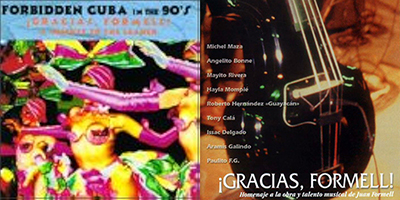 Then with some voice-leading, a bar of B7(#5) - a most traditional harmonic movement. The horns play a terrific little figure that ends with a cluster of notes carrying over into the new key area of E major. Within the story in the lyrics, our novios speak of dreams, dreaming that includes some fantasy career hopes as well. Then with some voice-leading, a bar of B7(#5) - a most traditional harmonic movement. The horns play a terrific little figure that ends with a cluster of notes carrying over into the new key area of E major. Within the story in the lyrics, our novios speak of dreams, dreaming that includes some fantasy career hopes as well.As the story of these novios moves along in letter [B], the lyrics are caressed with some harmonic touches that did not appear in [A]. For example, in bar 6, instead of going to the anticipated D7(9), Ceruti takes us to C7(9b5) up from the Amaj7 - and that chordal touch leads us to Cb/Db, instead of what might have been D#ø7 - IF he had followed the 1st Verse. But, he gets us back to the V7 chord of F#m7(sus)/B before the Verse 4 begins. Here the lovely transition is handled by the arrival of our coro, in this case the voices are all female and the girls sing in clustered harmony. This is one of my favorite touches in the arrangement because, often times in Salsa, the sound of multiple female voices is not used. Within [B2] we learn that, over an ice cream, the novia wants to become a teacher. Once again, Ceruti gives us some new chordal touches that differentiate this verse from [A2]. In bar 2, instead of using a iim-V7 to turn us back around to the root of Emaj7, he goes to the ivm7, and then passes chromatically down to Abm7 before finally arriving at the iim7-V back to home base, Emaj7. Adding another nice touch by having the horns reappear in the middle of a verse, playing a counterline which helps to highlight these new chord changes. From bars 5-7 the chordal movement is similar to [A2], but the section is extended by 2 extra bars as we are about to modulate up another whole-step heading to Gbmaj7. Once again, the horns are used to help to add some subtle emphasis that we are changing keys. For me, this aspect of arranging shows great thought and creativity. In order to try to make relatively certain that I was going to be presenting the lyrics to "La Habana Joven" correctly, I endeavored to find them on the web but even I could hear that the lyrics from the original Los Van Van recording were slightly different than Ángel Bonne's delivery. So, in a minor state of panic, I called upon another close friend, Venezuelan pianist Antonio Mazzei, now living in Barcelona, to give both versions a listen, but to concentrate on the one that I am presenting here, so that you can read and best understand what was going on within the story of the song. So, to the best of our abilities, this is what I am now presenting to you below. La Habana de un bello color es un muro ya casi sin sol, me apresuro a encontrarme contigo en el Malecón [A2] 2nd Verse Conversamos muy juntas las caras y soñamos qué linda es la Habana. Pasa un barco y te digo que pronto seré capitán. Yo seré capitán [B] 3rd Verse Caminamos después por un parque se retiran los niños, ya es tarde, en silencio te miro a los ojos, después me sonrío (Girls) y tú te sonríes. [B2] 4th Verse Saboreando un helado me cuentas que quisieras al fin ser maestra, eres joven y pronto tus sueños serán realidades. Serán realidades 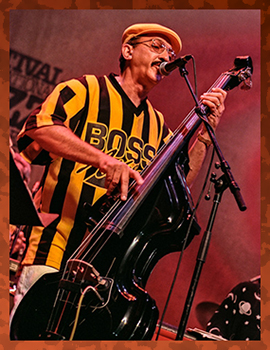 [C] 5th Verse Se hace tarde. Salimos corriendo, ya tu guagua está casi partiendo. Me despido entre besos y espero llegue otra semana (Girls) otra semana [C2] 6th Verse Juventud que es divino tesoro yo soy joven y lo tengo todo, una escuela en el campo y un fin de semana en la Habana. 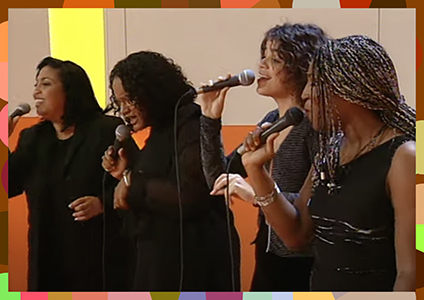 Coro 1 En la Habana te espero Y verás que te quiero [Repeat] Coro 2 Bésame, ámame que te quiero Bésame, ámame que me muero de amor [Repeat] With the arrival of Gb major and letter [C], our novios are running late and she has to catch her bus (guagua), which is just about to leave, as they say goodbye with some kisses. Nice, right? Marking the growth of the love story, Ángel adds a harmony part to his lead vocal, while the chords in 1st 5 bars mirror the ones that we heard in [B]. However, from that point forward, Juan Manuel Ceruto takes a different path passing through Ab7(13) to Ab7#5, and then a really nice surprise of Gmaj7 - 1/2-step above where we are headed - back to Gbmaj7. All the while, in bar 4, our horn section appears with a quick line bringing us back to the Imaj7 chord. And, as we hit the aforementioned Gmaj7, the girls return to sing some clustered harmonies to accentuate the surprise of that Gmaj7 chord as they repeat after Ángel singing, "otra semana".... [C2] brings with it our 6th and last verse of the song, and the story. Here, our beloved Formell salutes the beauties of youth and its innocence by stating, "I am young and I have everything. A school in the country, and a weekend in Havana." What could be better? Here, Juan Manuel Ceruto's harmonies mirror a path taken for most of [B2], but in bar 6, he reveals designs to move us in a different direction which, this time, 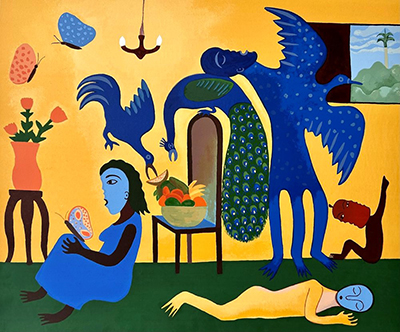 is supplied by a 10-bar Horn Interlude which eventually leads us to a richness in harmony supplied by more dominant 7sus chord sounds centered around Db/Eb or Eb7(9sus). For me, and I remember the 1st time that I heard this song, it was a wonderful journey, and there was even more to come. All housed within a 4:43 song!!! That is a relatively short time to have given us so many points of interest - not to mention a great story in song. is supplied by a 10-bar Horn Interlude which eventually leads us to a richness in harmony supplied by more dominant 7sus chord sounds centered around Db/Eb or Eb7(9sus). For me, and I remember the 1st time that I heard this song, it was a wonderful journey, and there was even more to come. All housed within a 4:43 song!!! That is a relatively short time to have given us so many points of interest - not to mention a great story in song.Letter [D], which I have labeled as [Coro 1], marks the reappearance of, and in full force, the spectacular voices of Gema 4 within this song, in other words, our Coro. They first appeared in bar 7 of Letter [B] as it transitioned to [B2] using rich sounding 3-part harmony, often clustered on the final voicing. You heard more harmonies in the voices over the Gmaj7 chord leading to [C2]. After the 10-bar horn interlude, the girls of Gema 4 come in with, at the very least, 4-part harmonies, which in a context like this with lush harmonies coming from the Rhodes of Emilio Morales, reminiscent of something the great keyboardist/arranger/composer Clare Fischer might done early on for the vocal group the Hi-Lo's, dating back to the late '50s. In the most contemporary light, no one is better at this kind of vocal group mastery than Take 6 - how glorious they are. What the voices of the girls add here is so special, because one rarely, if ever, hears these kinds of vocal harmonies in Salsa. For me, as a fan of such things, it was so refreshing to hear them in the context of this wonderful love song. Notice the terrific sense of group internal dynamics as they introduce these vocal colors. Now that I have learned that it was Gema 4 singing, I am certain that they came into the studio, perhaps already having heard the arrangement, and created these harmonies themselves. No one would know better about the possible where voices are concerned. So, one huge BRAVO! to them! The horn [Moña] arrives at [D2] and here, our compact horn ensemble, probably with 2 trumpets, 1 tenor sax and a trombone guide us through this 8-bar section with some very Jazzy lines that J.M. Ceruti must have written. Notice the phrasing, the great short notes and the phrases that end with long-short phrasing - all so very important in Jazz, R&B and Salsa. Even though the chords are moving from Db/Eb, for the most part the lines appear to be derived from Eb minor pentatonic [Eb, Gb, Ab, Bb, Db], which gives everything a bluesy feeling even inside the lush harmonic cushion. The unison nature of the lines is broken occasionally for a chordal stab, for example, at the end of bar 2, and on the and-of-3 in bar 4. As a piano, or synth version of a piano, enters with a montuno at [D3], which I have labeled as [Coro 2], Gema 4 arrives with a different set of lyrics and more wonderful harmonies as Ángel improvises around them. It's all very sabroso in a uniquely traditional way. The vocal colors added throughout are such a great touch to these ears. Congratulations to everyone involved. I'm so happy that someone helped me to uncover the mystery of the names of all of the musicians and singers! Yu-pi!!! As we finally arrive at Letter [E], which I would label as the [Tag] for the arrangement, it is once again instrumental in nature, mostly featuring, to these ears, two(2) trumpets and a trombone with lines over the same harmonies that we heard in the moña of [D2]. It's interesting that, even though Db/Eb, fundamentally a dominant 7th chord - presented here as a slash chord abbreviation for Eb7(9sus). Usually any dominant 7th chord has a lot of latitude for lines that can always include a certain bluesiness and here, that, to me, is represented by the appearance of Gb's (what some would call the m3rd) a blue note in the lines. For the most, even though the chords are changing: Db/Eb to Cb/Db to Gb7 to Ab7 to Ab/Bb, and lastly a nice b5 sub, E7(13) - the lines have notes from Eb minor pentatonic [Eb, Gb, Ab, Bb, Db], except the Db never really appears, but we do see F-naturals. Lastly, we have the very forceful 16th-note syncopated horn accents in bar 4 of each phrase, which I now hear as just 2-notes: G# and E-natural played by the 2 trumpets. As the 4 bar phrase is going to repeat, that high G# eventually becomes Ab (enharmonically spelled, it is the same note) as the top voice of Db/Eb, which is a nice harmonic touch. 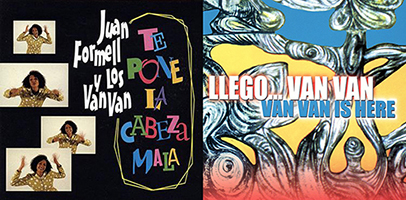 That same syncopated figure on the repeat ends the song! In the end, the section is 16 bars in length and ends with that forceful figure played by all in bar 16. That same syncopated figure on the repeat ends the song! In the end, the section is 16 bars in length and ends with that forceful figure played by all in bar 16.It just wouldn't seem right not to say something of a personal nature about my feelings for the music of Juan Formell's Los Van Van. What a remarkable group, and for so many decades of great music. Here are a couple of favorite albums of mine which, no doubt, came to me via hanging-out in the Salsa clubs of New York and asking questions as the music played, like: "Wow! Who is THAT?!?!?!?" At that time, no doubt this album and its title song was one of the first to arrive: "TE PONE LA CABEZA MALA"(EMI)(1997) which featured the powerful title song: "Esto Te Pone La Cabeza Mala." On this one, I just love the voice and spirit of Roberto "Robertón" Hernández! Some 2 years later came: "LLEGO... VAN VAN"(Atlantic)(1999)! One of my many favorite songs on this great album was: "La Bomba Soy Yo." This song featured the vocals of Mario "Mayito" Rivera. The lyrics to this tune are simply priceless - they make me smile and laugh every time that I hear them. It's just fantastic storytelling! "Pa' que te haces?" I have tried to make it as easy as is possible for those of you, who might be new to all of this, to, at the very least, listen to a couple of these songs via YouTube. The links are right here within this paragraph. So, listen and enjoy these fantastic songs! In closing, I wanted to again acknowledge the passing of the legendary bassist, composer, bandleader for the illustrious Los Van Van, Juan Formell, who passed away on May 1st, 2014 at the age of 71 in Havana, Cuba. Formell's musical vision and legacy since his passing have been carried forward by his son, drummer Samuel Formell who helps to lead the great band along a number of other bandmates who have been there forever. It's fantastic to know, though from afar, that this vibrant music from Cuba lives on and goes forward, always forward!!! So, for my small part as a humble fan, I salute you Juan Formell, and wish that you will always rest in peace. Q.E.P.D.! With love and great respect, Steve Khan, New York
[Photos: Juan Formell Portrait
Ángel "Angelito" Bonne Juan Formell and his beloved Baby Bass Gema 4 1999 on TV Manuel Mendive Painting - Sr. Mendive is mentioned in the lyrics to Los Van Van's "La Bomba Soy Yo"] |